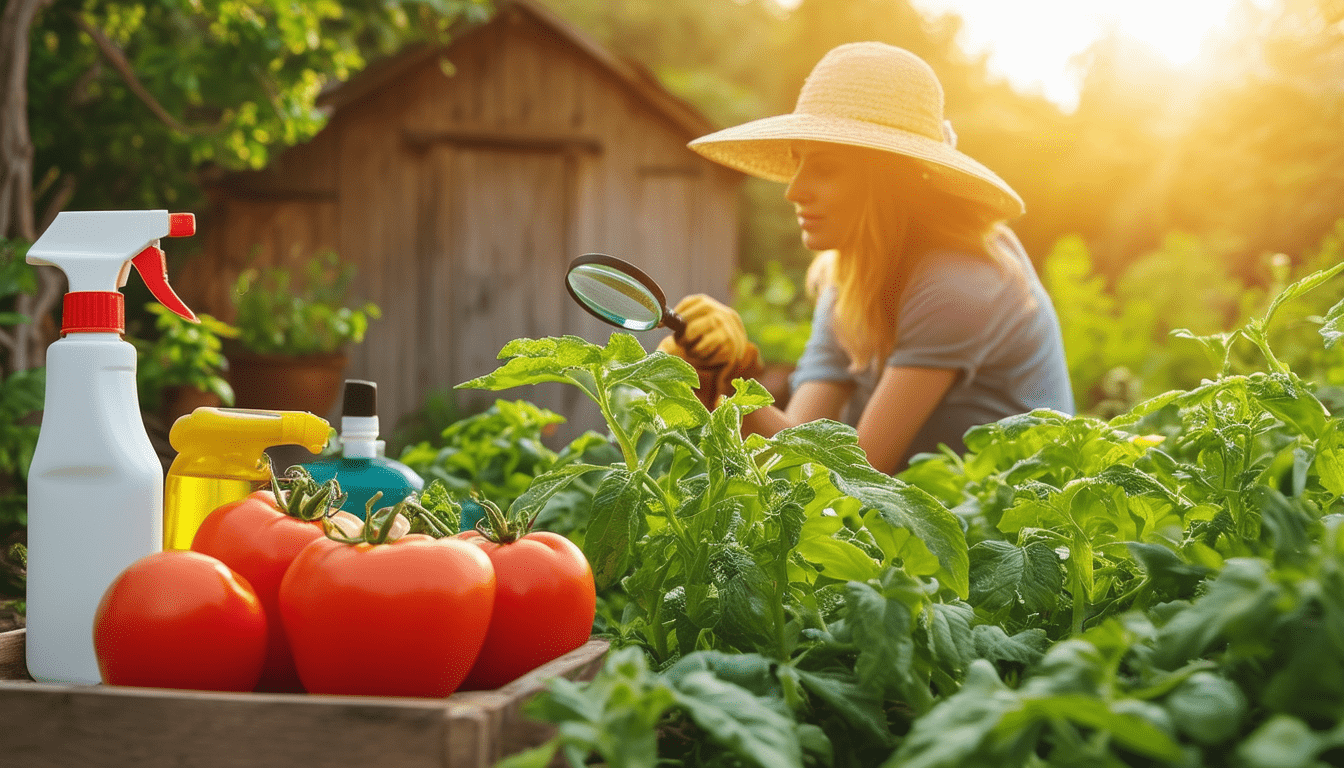Effective strategies for pest management in gardens
|
IN BRIEF
|
In the realm of gardening, effective pest management is crucial for maintaining healthy plants and ensuring a bountiful harvest. Different strategies can be employed to combat garden pests, many of which fall under the umbrella of Integrated Pest Management (IPM). By utilizing a combination of organic methods, cultural practices, biological controls, and physical barriers, gardeners can create a balanced ecosystem that minimizes the need for harmful chemicals. Understanding how to implement these pest control techniques not only promotes sustainability but also fosters a thriving garden environment that benefits both plants and beneficial organisms.

Maintaining a healthy garden is an essential pursuit that every gardener cherishes. However, the presence of pests can disrupt the balance and threaten the vitality of plants. Embracing Integrated Pest Management (IPM) offers a holistic approach to tackle these challenges effectively. This article outlines several practical strategies and tools that can be utilized to manage pests in gardens successfully, ensuring both sustainability and eco-friendliness.
Understanding Integrated Pest Management (IPM)
The foundation of effective pest management lies in understanding Integrated Pest Management (IPM). This approach involves regular monitoring, accurate identification of pests, and the implementation of a combination of strategies to prevent and control pest populations. IPM emphasizes sustainability and focuses on minimizing harm to beneficial insects, the environment, and human health. By prioritizing prevention and employing a range of tactics, IPM fosters a thriving and resilient garden ecosystem.
Organic Pest Control Methods
One of the most practical ways to manage pests is through organic pest control methods. These include utilizing naturally occurring substances and organisms to deter or eliminate pests without harming the environment. Common organic strategies include the use of neem oil, insecticidal soaps, and diatomaceous earth, which target specific pest types. Additionally, introducing beneficial insects like ladybugs and lacewings can naturally reduce pest populations. Understanding the appropriate application timing and method is crucial for achieving effective results.
Encouraging Biodiversity
Biodiversity plays a vital role in pest management as it creates a balanced ecosystem within the garden. By planting a diverse range of species, gardeners can reduce the likelihood of pest infestation due to the presence of predatory insects and natural repellents produced by various plants. For example, incorporating flowering plants such as marigolds can attract beneficial insects that prey on common garden pests. A well-thought-out planting strategy not only enhances the aesthetic appeal of the garden but also reinforces the natural pest control mechanisms.
Physical and Mechanical Controls
Another effective approach to managing pests is through physical and mechanical controls. These methods involve using barriers to keep pests away or employing traps to capture them. Gardeners can utilize row covers, nets, or floating row covers to protect vulnerable plants from pests. Handpicking larger pests or using traps for specific insects can also yield positive results. Regular checks and maintaining cleanliness in the garden further limit pest hiding spots, reducing their presence over time.
Planting Resistant Varieties
Selecting pest-resistant plant varieties is a proactive strategy. Many plants have been bred or genetically modified to withstand specific pests or diseases. By incorporating these varieties into the garden, the risk of serious infestations is diminished. Additionally, understanding the seasonal behavior of pests allows gardeners to plant crops before peak pest periods, minimizing potential damage and ensuring a healthy yield.
Cultural Practices and Maintenance
Implementing good cultural practices is crucial for effective pest management. Regular maintenance, such as clearing debris, pruning overgrown foliage, and rotating crops, creates an inhospitable environment for pests. Crop rotation introduces a diversification of nutrients and disrupts pest life cycles, making it challenging for them to establish themselves. Furthermore, using compost and organic fertilizers nourishes plants and increases their resilience to pest attacks.
Utilizing Non-Toxic Repellents
Non-toxic repellents, whether commercially available or homemade, can provide an additional layer of protection against pests. Essential oils such as peppermint, rosemary, and lavender can be effective in deterring pests without causing harm to the surrounding ecosystem. Regular applications, especially after rainfall, ensure persistent enforcement of this protective measure, creating a formidable barrier against unwanted visitors in the garden.
Employing a multifaceted approach to pest management ensures that gardens remain healthy and vibrant. Understanding the principles of IPM, integrating various organic control methods, encouraging biodiversity, using physical barriers, cultivating resistant varieties, and practicing diligent maintenance collectively form a strong foundation for sustainable gardening. Each strategy complements the others, contributing to the overall resilience of the garden environment.
For further insights and detailed information, consider exploring resources such as the USDA’s guidelines on IPM, or the benefits of hydroponic systems that can be implemented alongside traditional gardening methods. Take an active role in fostering a thriving garden while caring for the environment through these effective pest management strategies.
| Strategy | Description |
| Integrated Pest Management (IPM) | A holistic approach combining multiple pest control methods to reduce pest populations sustainably. |
| Beneficial Insects | Encouraging natural predators like ladybugs and lacewings to maintain pest levels. |
| Pest-Resistant Varieties | Selecting plant varieties that are naturally resistant to specific pests or diseases. |
| Cultural Practices | Implementing garden practices such as crop rotation and timely planting to disrupt pest cycles. |
| Physical Barriers | Using nets, row covers, and traps to physically prevent pests from reaching plants. |
| Natural Repellents | Utilizing eco-friendly substances like neem oil or diatomaceous earth to deter pests. |
| Sanitation | Regularly clearing debris and weeds that can harbor pests to maintain garden health. |

Managing pests in gardens is a critical aspect of horticulture that ensures plants thrive while minimizing damage from unwanted organisms. Utilizing integrated pest management (IPM) tactics equips gardeners with a variety of methods to control pest populations effectively. This article delves into several effective strategies that encompass organic methods, preventive measures, and the promotion of biodiversity, all tailored for successful garden pest management.
Understanding Integrated Pest Management (IPM)
Integrated pest management (IPM) is a comprehensive strategy that combines different management approaches and practices to control garden pests. By understanding the life cycles and behaviors of pests, gardeners can implement targeted measures that address specific infestations while minimizing harm to beneficial insects and the environment. This sustainable approach is recognized and recommended by the USDA for effective pest management.
Utilizing Organic Pest Control Methods
Organic pest control methods provide an eco-friendly alternative to chemical pesticides. These methods include the use of natural repellents, such as garlic or neem oil, which deter pests without harming beneficial species. Additionally, introducing beneficial insects, like ladybugs and lacewings, can naturally control infestations by preying on harmful pests.
Promoting Biodiversity
Increasing biodiversity is one of the most effective strategies for pests management in gardens. Having a wide variety of plants not only enhances the aesthetic appeal but also creates a complex ecosystem that makes it challenging for pests to dominate. Diverse plantings can attract predators and reduce the likelihood of pest outbreaks (source).
Planting Pest-Resistant Varieties
Choosing pest-resistant plant varieties is a proactive measure every gardener should consider. These plants have been bred to withstand common pests, helping to minimize pest problems. Incorporating these varieties into your garden plan can significantly reduce reliance on chemical control measures.
Implementing Cultural Practices
Cultural practices such as crop rotation and planting at optimal times can effectively manage pest presence. Planting early or late can help bypass periods of peak pest activity, thus avoiding encounters with pests during their most active phases. This strategy can be part of a larger plan that includes guidelines provided by resources like Penn State Extension (source).
Physical Barriers and Mechanical Devices
Using physical barriers such as row covers or garden fabrics is a straightforward yet effective strategy to fend off pests. These barriers physically prevent pests from reaching your plants while allowing sunlight and moisture to penetrate. Additionally, mechanical devices like traps can provide targeted control of certain pests without disrupting the entire ecosystem.
Regular Garden Maintenance
Routine maintenance is a crucial element in pest management. Keeping your garden clean and free of debris reduces potential habitats for pests. Regularly checking plants for early signs of infestations allows for timely intervention, preventing pests from spreading and causing widespread damage. Clear your garden to deter pests from finding suitable homes (source).
Implementing these effective strategies for pest management will not only create a healthier garden but also promote an environmentally-friendly approach to gardening. By combining cultural practices, organic methods, and promoting biodiversity, gardeners can successfully tackle pest issues and enhance their gardening experience.
- Prevention: Implement practices to deter pests before they appear.
- Integrated Pest Management (IPM): Utilize a combination of methods for effective pest control.
- Beneficial Insects: Encourage habitats for natural predators like ladybugs.
- Pest-Resistant Varieties: Select plants that are less susceptible to pest infestations.
- Physical Barriers: Use nets and row covers to protect plants.
- Cultural Practices: Rotate crops and adjust planting times to reduce pest populations.
- Natural Repellents: Employ homemade or non-toxic solutions to ward off pests.
- Regular Maintenance: Clear debris and weeds to eliminate pest habitats.

Managing pests in the garden is crucial to maintaining a healthy and thriving environment for plants. Adopting Integrated Pest Management (IPM) is essential, as it promotes sustainable practices that reduce pest populations while minimizing ecological impacts. This article will outline several effective strategies for controlling garden pests, including preventative measures, ecological practices, and integrated approaches to pest management.
Prevention is Key
The first step in any pest management plan is prevention. By taking proactive measures, gardeners can significantly reduce the likelihood of pest infestations. A few preventive strategies include:
1. Choose Resistant Varieties
Selecting pest-resistant plant varieties can greatly diminish pest issues. Many plants are bred to resist specific pests or diseases. Researching and understanding which varieties thrive in your area can save you time, effort, and resources in the long run.
2. Maintain Garden Hygiene
Regularly clearing your garden of weeds and debris will minimize spaces where pests can hide and breed. A tidy garden is less inviting to unwanted insects and rodents.
Utilizing Beneficial Organisms
A lesser-known yet effective strategy involves encouraging beneficial organisms within your garden. These organisms can help control pest populations naturally.
1. Introduce Beneficial Insects
Attracting beneficial insects such as ladybugs, lacewings, and parasitic wasps can assist in controlling harmful pests. Consider planting flowers like marigolds and dill that attract these insects, creating a balanced ecosystem.
2. Create Diverse Habitats
Promoting biodiversity within your garden can significantly diminish the likelihood of pest infestations. A diverse range of plant species can provide habitats for various beneficial organisms, thus enhancing pest control.
Employing Ecological Control Methods
Beyond attracting beneficial organisms, there are several ecological control methods to consider for pest management.
1. Physical Barriers
Utilizing physical barriers such as row covers, nets, and even traps can help shield plants from unwanted pests. Ensuring that these barriers are properly installed is crucial for their effectiveness.
2. Crop Rotation
Implementing crop rotation reduces the build-up of soil-borne pests and diseases. By alternating the types of plants grown in a specific area, gardeners can disrupt the life cycles of pests and promote healthier soil.
Biological and Cultural Practices
Engaging in cultural practices can further help control pests effectively.
1. Timing Planting
Planting at the right time can drastically reduce the risk of pest attacks. For example, sowing seeds before or after peak pest seasons can help diminish the pressure on young plants.
2. Using Natural Repellents
Employing natural repellents made from essential oils or other organic ingredients can deter specific pests without harming the ecosystem. Garlic, neem oil, and diatomaceous earth are just a few examples of safe alternatives.
Monitoring and Evaluation
Finally, effective pest management requires ongoing monitoring and evaluation. Regularly inspecting plants and assessing pest populations will help gardeners adapt their strategies accordingly. By remaining vigilant, it becomes easier to identify new threats early on, leading to more effective interventions.


Post Comment